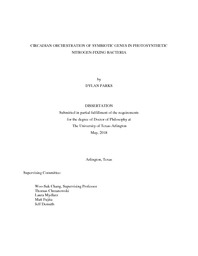
ATTENTION: The works hosted here are being migrated to a new repository that will consolidate resources, improve discoverability, and better show UTA's research impact on the global community. We will update authors as the migration progresses. Please see MavMatrix for more information.
Show simple item record
| dc.contributor.advisor | Chang, Woo-Suk | |
| dc.creator | Parks, Dylan | |
| dc.date.accessioned | 2018-06-05T17:52:18Z | |
| dc.date.available | 2018-06-05T17:52:18Z | |
| dc.date.created | 2018-05 | |
| dc.date.issued | 2018-05-04 | |
| dc.date.submitted | May 2018 | |
| dc.identifier.uri | http://hdl.handle.net/10106/27431 | |
| dc.description.abstract | Rhizobia have long been known for their symbiotic association with the roots of legumes where they perform nitrogen fixation in specialized organs called nodules. The photosynthetic strains of Bradyrhizobia are of particular interest because they possess both photosynthetic and nitrogen-fixing capabilities. Sequencing and analysis of the genomes of Bradyrhizobium sp. ORS278, Bradyrhizobium sp. BTAi1, and a novel strain, Bradyrhizobium oligotrophicum BO-1 have revealed that they do not contain the canonical nod genes which encode nodulation factors (NF) that initiate symbiosis. The NF-independent symbiotic pathway has been proposed for the relationship between the photosynthetic Bradyrhizobia and semi-aquatic Aeschynomene legumes. This symbiotic association could involve exchange of novel signaling molecules and mechanisms by which bacteria enter into the plant. To elucidate the relationship between photosynthesis and nitrogen fixation involved in the NF-independent pathway of the ORS278 strain, two genes involved in circadian regulation, BRADO4470 (labA) and BRADO3946 (chk), were mutated. Mutation of each gene hinders symbiotic efficiency and the nitrogen fixation process. Thus, we hypothesized that circadian regulation may optimize symbiotic processes since one aspect of the mutualism, the nitrogenase enzyme responsible for nitrogen fixation, is inhibited by oxygen produced during daytime photosynthesis. Indeed, acetylene reduction assay not only showed that the two mutants produce a nitrogen fixation-deficient phenotype, but that the wild type only performed nitrogen fixation actively during the night period. Genome-wide transcriptional profiling of ORS278 revealed that approximately 50% of genes are differentially expressed between night and day in the root nodule, primarily involving different metabolic processes including nucleoside monophosphate, cofactor, and porphyrin-containing compound metabolisms. To confirm the differential gene expression in the root nodule, a set of hosukeeping genes were identitifed for qRT-PCR experiments. Various microarray-based gene expression datasets from Bradyrhizobium japonicum USDA110 were used and homologs of the identified housekeeping genes (HKGs) were determined and tested in ORS278 and BTAi1. These genes appeared to be reliable in new treatments, including studies measuring gene expression at different times during the day. Since certain symbiotic properties are managed in a circadian fashion, it makes sense that the NF-independent pathway could be regulated temporally. Comparative genome analysis between ORS278, BTAi1, and the novel BO-1 strain, showed high similarity between genes involved in photosynthesis, nitrogen fixation, and symbiosis indicating that they may share the same type of regulatory mechanism, including the temporal management of their relationship with Aeschynomene indica. | |
| dc.format.mimetype | application/pdf | |
| dc.language.iso | en_US | |
| dc.subject | Circadian | |
| dc.subject | Nitrogen-fixing bacteria | |
| dc.title | Circadian Orchestration of Symbiotic Genes in Photosynthetic Nitrogen-Fixing Bacteria | |
| dc.type | Thesis | |
| dc.degree.department | Biology | |
| dc.degree.name | Doctor of Philosophy in Quantative Biology | |
| dc.date.updated | 2018-06-05T17:54:26Z | |
| thesis.degree.department | Biology | |
| thesis.degree.grantor | The University of Texas at Arlington | |
| thesis.degree.level | Doctoral | |
| thesis.degree.name | Doctor of Philosophy in Quantative Biology | |
| dc.type.material | text | |
Files in this item
- Name:
- PARKS-DISSERTATION-2018.pdf
- Size:
- 2.720Mb
- Format:
- PDF
This item appears in the following Collection(s)
Show simple item record


